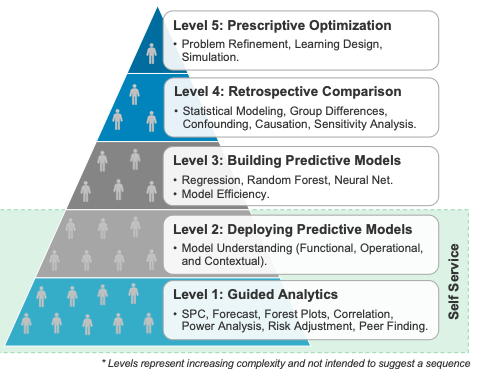As COVID-19 has strained health systems clinically, operationally, and financially, advanced data science capabilities have emerged as highly valuable pandemic resources. Organizations use artificial intelligence (AI) and machine learning (ML) to better understand COVID-19 and other health conditions, patient populations, operational and financial challenges, and more—insights that are supporting pandemic response and recovery as well as ongoing healthcare delivery. Meanwhile, improved data science adoption guidelines are making implementation of capabilities such as AI and ML more accessible and actionable, allowing organizations to achieve meaningful short-term improvements and prepare for an emergency-ready future.
 Download
Download

The healthcare industry has been progressing towards more widespread data science adoption for some time, but COVID-19-driven data and analytics demands have further motivated organizations to advance their artificial intelligence (AI) and machine learning (ML) capabilities. The data science journey has previously lacked actionable frameworks from implementation and adoption. However, more practical and outcome-driven guidelines, such as the Health Catalyst Data Science Adoption Model™, are helping organizations leverage AI and ML in support of their strategic goals. As a result, data science has meaningful impacts on leadership decision making, information security, revenue, operational outcomes, patient experience, and more.
An actionable data science adoption framework guides organizations through critical levels of analytics capabilities. For example, the Data Science Adoption Model (Figure 1) provides steps to help data science practitioners and leaders direct their analytic investments and deliver real value. As a result, decision makers bridge the gap between interest in data science and its real-world application, achieving measurable data-driven improvement across the health system.

As healthcare increasingly adopts advanced data science capabilities, such as AI and ML, organizations are improving outcomes across the continuum of care, including the following four examples:
While many healthcare organizations have implemented AI and ML tools at the point of care, few have successfully applied them to high-level decision making. However, as AI expands from “artificial intelligence” to “augmented intelligence,” it becomes more instrumental in improving healthcare leaders’ decision-making. Augmented intelligence can help leadership identify urgent issues, make future-oriented decisions, and navigate some of healthcare’s most complex problems, such as solving healthcare inequality.
Healthcare organizations today face more security threats than ever. Some security experts claim that an individual’s medical record can be sold for ten times what their credit card goes for on the black market, making it a common target for hackers. Fortunately, combining AI with human judgment is emerging as an effective healthcare data security strategy. Together, both resources power a highly accurate privacy analytics model that allows organizations to review access points to patient data and detect when a system’s EHR is potentially exposed to a privacy violation, attack, or breach. With specific techniques, including supervised and unsupervised ML and transparent AI methods, health systems can advance toward more predictive, analytics-based, collaborative privacy analytics infrastructures that safeguard patient privacy.
A health system can significantly improve its bottom line by collecting unpaid balances from patients for healthcare services. Uncompensated care can cost large health systems billions of dollars annually, making outstanding balances one of their highest costs. As a solution, propensity-to-pay tools help organizations target unpaid accounts by using AI to leverage external and internal financial and socioeconomic data and identify the likelihood that patients in a population will pay their balances (propensity to pay). With AI-powered propensity-to-pay insight, financial teams can focus their efforts on the patients most likely to pay and connect patients who cannot pay with charity care or government assistance. Both health systems and patients benefit, as patients can avoid bad debt and organizations receive compensation for the care they’ve delivered.
Many health systems struggle to effectively manage hospital patient flow—the movement of patients through the hospital from entry to discharge. Machine learning-powered tools and predictive models can help organizations improve patient flow for departments throughout the system. As a result, organizations can reduce patient wait times and staff overtime and improve patient outcomes and patient and clinician satisfaction while avoiding common challenges, including surgery delays or cancellations, clinician and overload and burnout, emergency department overcrowding, and more.
As post-COVID-19 healthcare continues to rely on advanced data science to better understand diseases and health conditions, patient populations, operational and financial challenges, and more, AI and ML will continue to play pivotal roles in new-normal decision making. Health systems with an actionable data science strategy will be able to leverage advanced predictive capabilities and deeper operational and environmental understanding to better care for their patients and prepare for future challenges and crises.
Would you like to learn more about this topic? Here are some articles we suggest:
Would you like to use or share these concepts? Download the presentation highlighting the key main points.